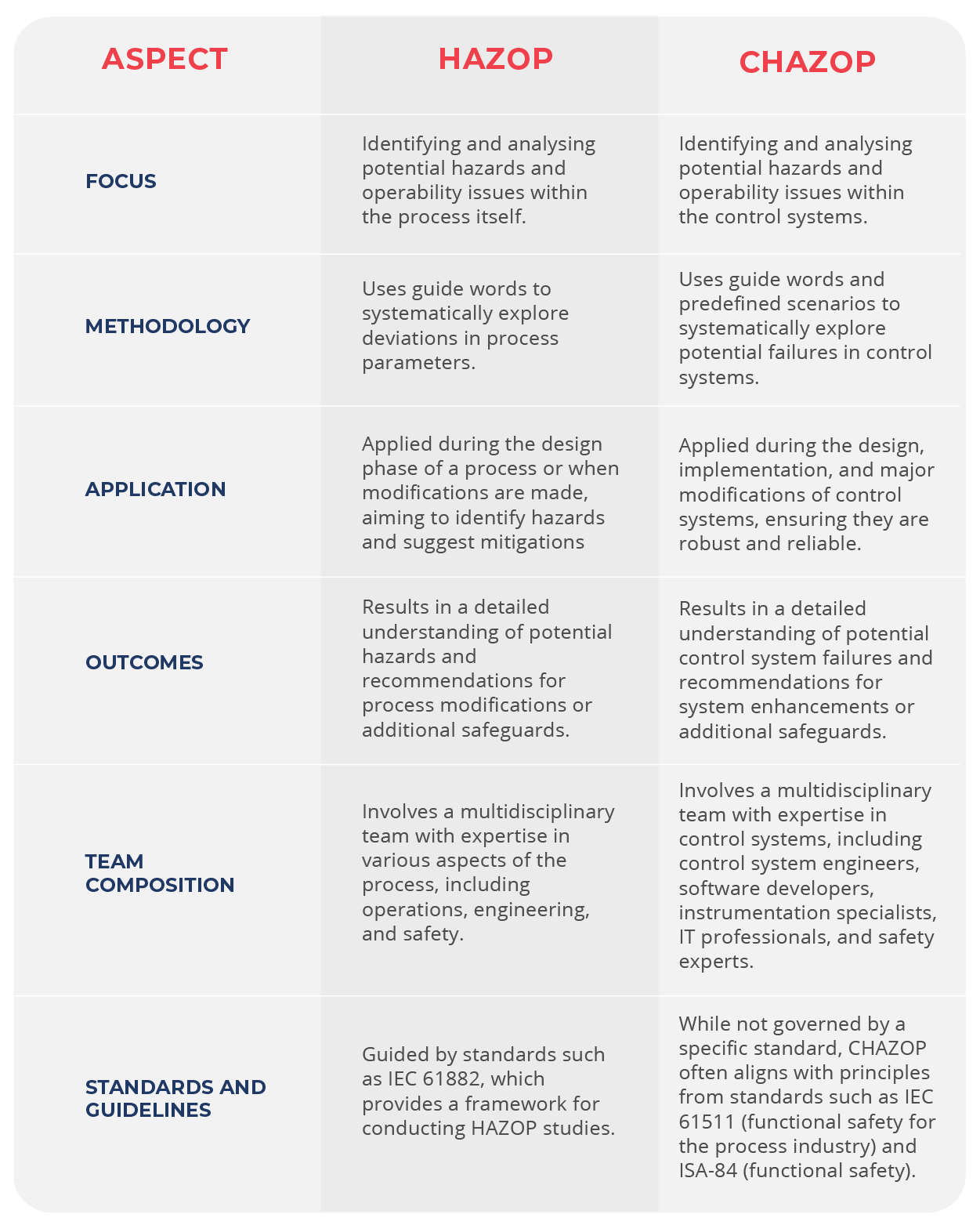Peter Henderson
In the world of process safety and hazard analysis, Hazard and Operability Studies (HAZOP) are well-known and widely used. However, another valuable tool in the safety arsenal is the Control Hazard and Operability Study (CHAZOP). While both methodologies aim to enhance safety and operability, they focus on different aspects of the process and control systems. This post compares HAZOP and CHAZOP, their methodologies, applications, and how they complement each other in ensuring comprehensive process safety.
What is HAZOP?
A HAZOP, or Hazard and Operability Study, is a structured and systematic examination of a planned or existing process or operation. The primary goal is to identify and evaluate potential hazards and operability problems that could lead to unsafe conditions or sub-optimal performance.
HAZOP Methodology
- Team-Based Approach: HAZOP involves a multidisciplinary team that brings together diverse expertise. This team typically includes process engineers, operators, safety professionals, and other relevant stakeholders.
- Guide Words: The study uses predefined guide words (e.g., “no,” “more,” “less,” “as well as”) to systematically examine each part of the process. These guide words help in generating possible deviations from normal operations.
- Nodes: The process is divided into manageable sections called nodes. Each node is examined for deviations using the guide words.
- Deviations and Consequences: For each deviation identified, the team assesses potential causes and consequences. They also consider existing safeguards and suggest additional measures if necessary.
Objectives:
- Identify potential hazards and operability issues.
- Understand the causes and consequences of deviations.
- Recommend modifications or additional safeguards to mitigate risks.
Applications:
HAZOP is widely used in various industries, including chemical processing, pharmaceuticals, oil and gas, and power generation. It is typically conducted during the design phase of a new process or when significant modifications are made to an existing process.
What is CHAZOP?
A CHAZOP, or Control Hazard and Operability Study, focuses specifically on the control systems of a process. It examines the hardware and software used for process control, automation, and safety instrumented functions, aiming to identify potential control system failures that could impact safety and operability.
CHAZOP Methodology
- Team-Based Approach: Similar to HAZOP, CHAZOP involves a multidisciplinary team. However, this team often includes control system engineers, software developers, instrumentation specialists, and IT professionals, in addition to process engineers and safety experts.
- Guide Words and Scenarios: CHAZOP uses guide words and predefined scenarios to examine potential failures in control systems. These scenarios might include software bugs, hardware malfunctions, network failures, and human-machine interface (HMI) issues.
- Nodes or Segments: The control system is divided into nodes or segments, such as individual control loops, safety instrumented systems (SIS), or communication networks. Each segment is examined for potential failures and their consequences.
- Failure Modes and Effects: For each identified failure mode, the team assesses the potential effects on the process and control system. They consider existing safeguards and recommend additional measures to enhance reliability and safety.
Objectives:
- Identify potential failures in control systems.
- Assess the impact of control system failures on process safety and operability.
- Recommend modifications or additional safeguards to mitigate risks associated with control system failures.
Applications:
CHAZOP is applied in industries with complex control systems, such as chemical processing, pharmaceuticals, oil and gas, power generation, and manufacturing. It is particularly valuable during the design and implementation of new control systems, as well as during major upgrades or modifications to existing systems.
Both HAZOP and CHAZOP methodologies require a robust action tracking methodology to support the actions that will invariably be generated as a result of the studies. Please refer to our Action Tracker page for more information on our high-governance action tracker which is used worldwide for all kinds of process safety-related actions.
Key Differences Between HAZOP and CHAZOP
While both HAZOP and CHAZOP are essential for process safety, they differ significantly in their focus, methodology, and application.

Complementary Roles of HAZOP and CHAZOP
Despite their differences, HAZOP and CHAZOP are complementary tools in the process safety toolkit. HAZOP is often the first step in identifying potential hazards within the process itself, which then informs the need for reliable control systems. CHAZOP ensures that these control systems are designed and implemented to handle potential failures effectively.
For example, a HAZOP study might identify a potential overpressure scenario in a chemical reactor. The study could recommend a safety instrumented function, such as a pressure relief valve, to mitigate this risk. A subsequent CHAZOP study would then examine the control system responsible for actuating the pressure relief valve, ensuring that the control logic, sensors, and actuators are reliable and can respond appropriately in the event of a pressure increase.
By integrating HAZOP and CHAZOP, organisations can achieve a comprehensive understanding of their process risks and ensure that both the process and the control systems are robust and reliable. This integration is critical for achieving a high level of safety and operational reliability.
Case Study: Integrating HAZOP and CHAZOP
Consider a pharmaceutical manufacturing facility undergoing a major upgrade to its control system. The facility uses automated processes for mixing and reacting chemical ingredients. Here’s how HAZOP and CHAZOP can be integrated:
- HAZOP Study: The multidisciplinary team conducts a HAZOP study on the new process design. They identify potential hazards, such as incorrect ingredient addition, temperature deviations, and pressure build-ups. The team recommends additional safeguards, including automated shutdown systems and enhanced monitoring.
- CHAZOP Study: Following the HAZOP, a CHAZOP study is conducted on the upgraded control system. The team examines the control logic, HMI, network reliability, and software integrity. They identify potential failure modes, such as software bugs that could lead to incorrect ingredient mixing or network failures that could disrupt monitoring.
- Integration and Mitigation: The findings from both studies are integrated. The process engineers and control system engineers collaborate to ensure that the control system enhancements align with the HAZOP recommendations. Additional safeguards, such as redundant sensors and fail-safe mechanisms, are implemented to address the identified risks.
- Testing and Validation: Before full implementation, the integrated system undergoes rigorous testing and validation. This includes simulation of potential failure scenarios identified in both HAZOP and CHAZOP studies to ensure that the system responds correctly and safely.
- Ongoing Monitoring and Review: After implementation, the facility establishes a routine for ongoing monitoring and periodic reviews. This ensures that both the process and control systems continue to operate safely and efficiently, and any new risks are promptly addressed.

Conclusion
HAZOP and CHAZOP are both integral to managing process safety, but they serve distinct purposes and are used at different stages of the safety lifecycle. HAZOP focuses on identifying and analysing potential hazards and operability issues within the process itself, while CHAZOP focuses on ensuring that the control systems are robust and reliable.
Understanding the differences between these methodologies and how they complement each other is essential for anyone involved in process safety. By leveraging both HAZOP and CHAZOP, organisations can effectively identify hazards, assess risks, and implement robust safety systems that protect people, the environment, and assets. This holistic approach to safety ensures that both the physical process and the control systems are designed, implemented, and maintained to the highest standards, thereby achieving a comprehensive and effective safety management system.
